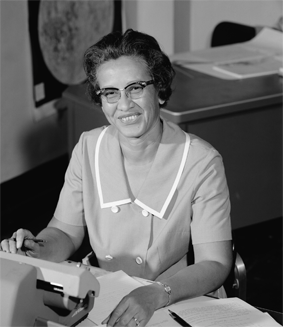
Katherine Coleman was born on August 26, 1918 in White Sulphur Springs, West Virginia (becoming Katherine Johnson when she later married.) Showing early signs of intelligence beyond her age cohort, she was placed in grade 2 at age 5 and by age 10 was ready for high school.
Since there was no secondary school for black children in White Sulphur Springs, Katherine attended West Virginia State High School from which she graduated in 1932 with a full scholarship to West Virginia State College. Her math teacher at that college was James Carmichael Evans who had a masters degree from MIT and who became her mentor. Katherine later said that she worked extremely hard to please him and his wife who, having no children of their own, treated her as if she were their child.
Katherine was further mentored by Professor William Claytor who created a special course for her in analytic geometry–something that would serve her well in her future occupation. In 1937, she graduated from West Virginia State College with a B.S. “summa cum laude,” majoring in mathematics and French.
In the years that followed, Katherine taught in a number of elementary schools in Virginia and West Virginia, got married and had three daughters, all of whom became mathematics teachers or mathematicians.
In 1952, before the ubiquity of computers, Katherine was hired by NACA (National Advisory Committee for Aeronautics later becoming NASA) to perform detailed mathematical calculations for the space program. Katherine Johnson, applied the equations of rocket science, things she had learned in her study of analytic geometry to calculate the trajectories, launch windows, and emergency return flights for Alan Shepard and John Glenn. For her contributions to the US space program, she received the Presidential Medal of Honor in 2015. In 2016 the movie Hidden Figures featured Katherine and the other African American women, who served NASA as human computers during the space race, outlining their struggle against racial prejudice. Katherine Johnson is but one example of many black people who have demonstrated exceptional ability in mathematics, verifying that no inferences about an individual’s intelligence can be drawn from comparisons of intelligence by race.
Reflecting on her work during the Space Race, Katherine explained:
Everything was so new – the whole idea of going into space was new and daring. There were no textbooks, so we had to write them. We wrote the first textbook, starting from scratch. People would call us and ask, “what makes you think that this or that is possible?” and we would try to tell them. We created the equations needed to track a vehicle in space. I was lucky that I was working with the division that worked out all the original trajectories, because I guess that is what I am remembered for.
